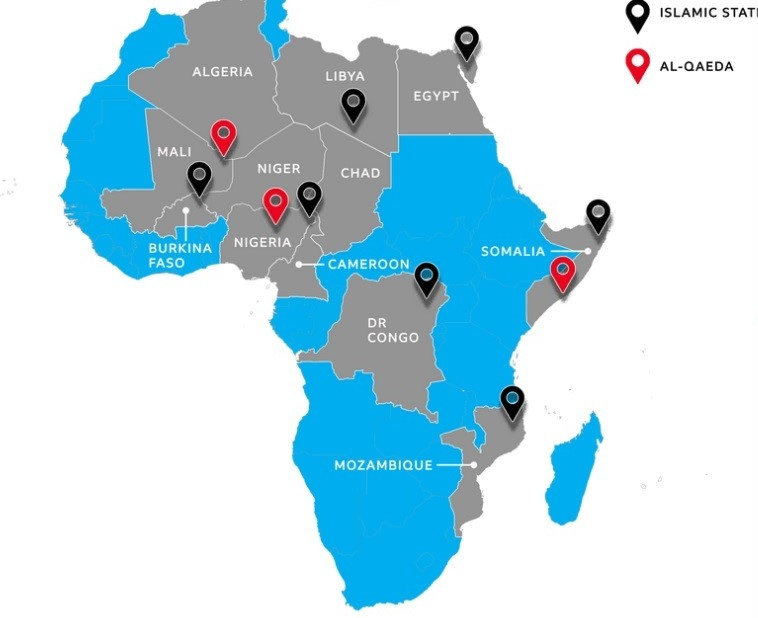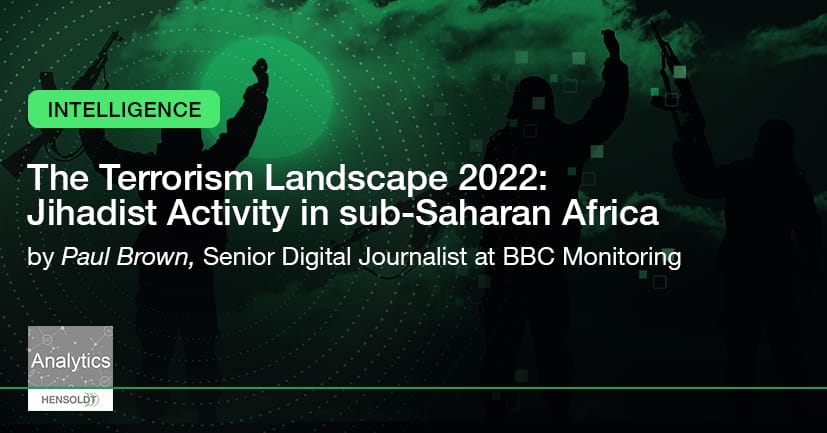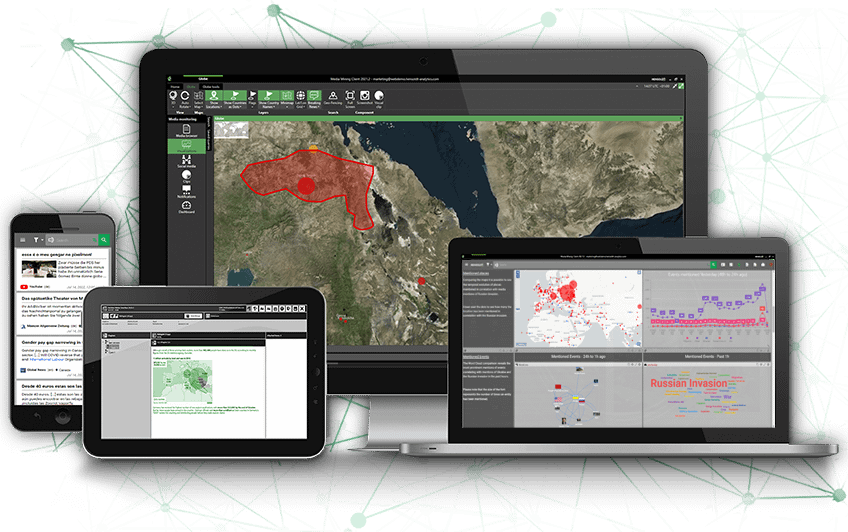This is a summary of The Terrorism Landscape: Emerging Trends Intelligence Webinar. You can request the recording of the webinar here or listen to a portion of the discussion in the bonus episode of the Intelligence Brief Podcast.
Paul Brown, Senior Journalist with a specialist team at BBC Monitoring, is tracking and analyzing jihadist media output from jihadist groups and supporters around the world. During our Intelligence Webinar in May, he covered the latest developments of jihadist activity in sub-Saharan Africa, as well as pointed out key features of the jihadist media.
BBC Monitoring has teams all over the world looking at mainstream media and social media in various parts of the world. Paul Brown is part of the team of journalists, who focus on jihadist media more specifically. The team does not have contacts on the ground, however, they are monitoring what the jihadist groups and their supporters are releasing on various channels.
The Rise of the Islamic State in sub-Saharan Africa
The Islamic State and al-Qaeda groups are in proximity on the African continent. Additionally, they are very fierce rivals, which can influence the operations of either side. A good example of their rivalry, according to Paul, is in Somalia. Here, ISIS struggled to gain a foothold, since al-Shabaab is much more influential and much more powerful, and it has hindered the Islamic State’s operations in the country.

The Spread and Current Status of IS Groups in sub-Saharan Africa
Apart from Somalia, there are many other ISIS groups in Africa. For example, there is a very small branch in Libya, another one is in the Sinai province. According to Paul’s data, the latter has been gaining attention from the official media with some high-profile attacks. There are groups in the Sahel region, in Lake Chad and particularly in northeast Nigeria, although there has been recent expansion into other areas as well. Additionally, the Islamic State groups can be found in DR Congo and Mozambique.
Taking a quick look at the various affiliates across sub-Saharan Africa, one can find ISWAP (the IS West Africa Province) which is based in Nigeria; however, ISIS has also staged cross-border attacks in Cameroon, Burkina Faso, Chad and Niger. It is worth noting that, in March 2022, the Sahel province, which was previously part of the ISWAP, was granted its own independent status. A similar thing happened with the Central Africa Province, which used to be split into DRC and Mozambique, but now the Mozambique branch has also been granted its own independent status, as per the data gathered by BBC Monitoring.
These decisions have been announced in a low-key way and there are various implications for command following. Both decisions appear to have been made after the appointment of the new leader, Abu Hassan al-Hashimi al-Qurayshi, potentially giving a clue into his new strategies, according to Paul.
Attacks Carried by IS and the Expansion of Their Branches
It is worth noting that IS has a highly centralized media operation and they claim every single attack that they can, which differs from al Qaeda practices. Anything from someone throwing a Molotov cocktail to a suicide blast in a crowded mosque is claimed by the Islamic State group. Paul’s team at BBC Monitoring records every one of those attacks as they come through, ever since the fall of Raqqa in 2017. However, the team records strictly the number of attacks, not the impact of these attacks.

The attacks in the Central Africa Province started off subtly, followed by a growth in 2019, and finally, the number of attacks doubled between 2020 and 2021. ISWAP is now hugely influential, with a large number of attacks being staged all the time and, on the increase, according to the data collected. Paul commented that the provinces of Central Africa and West Africa are the only IS branches showing any signs of expansion. Overall, globally we can observe a decline in the number of attacks being perpetrated each year.

According to other data gathered by BBC Monitoring, the proportion of ISIS attacks staged by sub-Saharan African groups from the global total is on the rise, and, just in 2021, moved up to 29%, while for the first quarter of 2022 it looked closer to 40 per cent.

Iraq, one of the traditional heartlands of IS, consistently tops the list for the number of attacks annually. However, the new sub-Saharan branches are now tending to match Iraq’s numbers, or even surpass them at times. Apart from Iraq, where attacks skyrocketed in April 2022, showing the capacity IS can still call upon in this country when needed, Syria is another traditional heartland of IS. However, the country currently seems to be in terminal decline in terms of attacks staged. Even if there was a high-profile attack earlier in 2022, in terms of quantity the area keeps quite low numbers; and in 2021 it was even leapfrogged by the West Africa Province and the Afghan Khorasan Province (ISKP) in terms of total attacks staged.
ISIS Propaganda and the Importance of sub-Saharan African Operations
BBC Monitoring conducted a small survey on the first 16 issues of the year of the Islamic State’s official newspaper, Al-Naba. According to their findings, 11 of the 16 issues featured African operations, either on the cover or as the lead article. The number of operations going up appears to feed the IS propaganda, which seems to consequently feed the operations as well.

Another feature of ISIS propaganda in Africa, particularly in the West Africa Province, refers to acts of governance. The most common practices seem to be videos of the religious police destroying drugs, doing charity work in various areas, or even fighters going out into communities handing out food, sweets, or even money to people.
Paul mentions a video released in January 2022 by ISWAP, which is ‘a very striking and quite disturbing example’. This video is firstly showing young kids undergoing rigorous religious and combat training, then generating into a snuff movie, showing a highly staged piece of footage where the kids go into an abandoned building, discover captives inside and execute them on screen. This is, in Paul’s opinion, meant to prove that ISIS is present in this particular area for the long run and that they are keen on mobilizing the next generation of fighters.
IS Media and the Supporter Networks
The ISIS media is highly centralized, differentiating from other jihadist groups. The Islamic State has its own news agencies, its own newspaper, and everything is filtered through the official channels. This makes it a lot easier to monitor and gather data on them but it also means BBC Monitoring can’t offer the same kind of level of coverage of other groups.
BBC Monitoring has found that the official media is backed up by well-regimented supporter media networks across social media, which means official statements or materials are normally followed by translations, and many times even repurposed into new types of content. Some videos are modified with new intros, in order to make them available for sharing on different platforms or groups, and sometimes the supporter networks set up pages just to share various materials.
This means the supporter network is really instrumental to the spread of these materials and it’s often praised by the official outlets as well. When things die down a bit, they will encourage them or tell them that they have to step up and spread these messages even more.
Paul Brown concluded his presentation with the characteristics of IS media.
Al-Qaeda's Media Outputs and Developments
When asked about Al-Qaeda’s latest media outputs and developments, Paul admitted that in the case of Al-Qaeda, the media effort is much more difficult to monitor and finding coherence to their speech has also proved challenging. One of the observations he made about Al-Qaeda’s recent output is that it seems far less brutal than the ISIS material. According to Paul, this is in line with a broader trend that has seen Al-Qaeda present itself as a more pragmatic and reasonable alternative to ISIS, in line with its ambitions for political influence.
Al-Qaeda releases two or three videos per week about in-depth theological lectures on various subjects, which is not what people were used to seeing in the Bin Laden days. Paul noted that they seemed heavily influenced by the Taliban takeover of Afghanistan, which was taken by Al-Qaeda and by their supporters “as proof that if you stay resilient and steadfast you can bring results, you can gain the influence and power that you’re craving”.
On the other hand, the al-Shabab group based in Somalia still releases videos of combat or images of brutal attacks from history, but also images of people being targeted on the streets. At the same time, they run another series called ‘Inspire the Believers’, which features testimonies from a fighter or a militant talking about how idyllic life on the front line is. A key theme of these videos from al-Shabab is, as Paul points out, that one shouldn’t believe the lies about life in Somalia, such as lack of food or resources; the main message seems to be that a good life awaits you if you come and join the ranks of al-Shabab.





